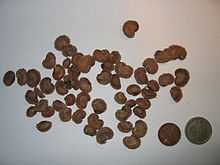Myrciaria
From Wikipedia, the free encyclopedia
Not to be confused with Myrcia, also in family Myrtaceae, or Myrica, in family Myricaeae, or Myricaria, in family Tamaricaceae.
| Myrciaria | |
|---|---|
 | |
| Seeds of M. dubia | |
| Scientific classification | |
| Kingdom: | Plantae |
| (unranked): | Angiosperms |
| (unranked): | Eudicots |
| (unranked): | Rosids |
| Order: | Myrtales |
| Family: | Myrtaceae |
| Subfamily: | Myrtoideae |
| Tribe: | Myrteae |
| Genus: | Myrciaria O.Berg[1] |
| Species | |
|
See text | |
| Synonyms | |
|
Myrciariopsis Kausel[1] | |
Myrciaria is a genus of large shrubs and small trees native to South America, especially Brazil. Common names include Jaboticaba, Jabuticaba, Guaperu, Guapuru, Hivapuru, Sabará, and Ybapuru.
The Jaboticabas are a significant commercial fruit in Brazil, where most species are native. The fruit is grapelike in size and appearance, and often likened to a muscadine grape in taste. M. dubia, the camu-camu berry, is grown primarily in flood-zone areas of Peru and has one of the highest vitamin C (ascorbic acid) concentrations of any fruit, alongside Terminalia ferdinandiana.
Selected species
- Myrciaria aureana Mattos
- Myrciaria ciliolata O.Berg
- Myrciaria cuspidata
- Myrciaria delicatula O.Berg
- Myrciaria dubia (Kunth) McVaugh – Camu-Camu
- Myrciaria floribunda (H.West ex Willd.) O.Berg – Rumberry
- Myrciaria glomerata O.Berg – Yellow Jaboticaba, tropical apricot
- Myrciaria pliniodes Legr.
- Myrciaria silveirana Legr.
- Myrciaria tenella (DC.) O.Berg
- Myrciaria trunciflora O.Berg – Jaboticaba de Cabinho
- Myrciaria vexator McVaugh – Blue Grape
- Myrciaria vismeifolia (Benth.) O.Berg[2]
Formerly placed here
- Plinia cauliflora (Mart.) Kausel (as M. cauliflora (Mart.) O.Berg and M. jaboticaba (Vell.) O.Berg)
References
| Wikimedia Commons has media related to Myrciaria. |
| Wikispecies has information related to: Myrciaria |
- ↑ 1.0 1.1 "Genus: Myrciaria O. Berg". Germplasm Resources Information Network. United States Department of Agriculture. 2009-01-27. Retrieved 2013-01-18.
- ↑ "GRIN Species Records of Myrciaria". Germplasm Resources Information Network. United States Department of Agriculture. Retrieved 2013-01-18.
This article is issued from Wikipedia. The text is available under the Creative Commons Attribution/Share Alike; additional terms may apply for the media files.